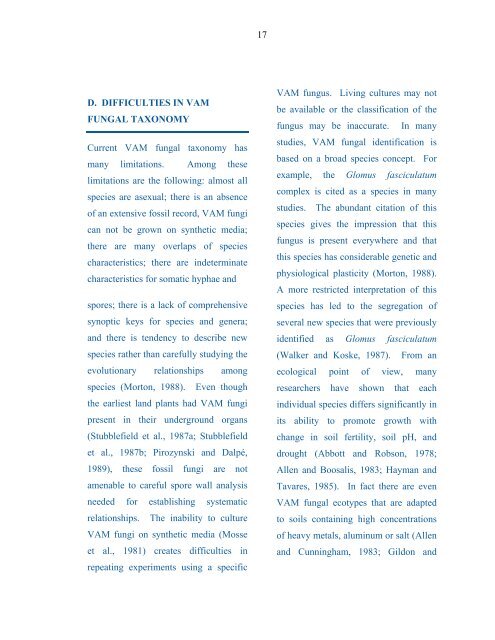Taxonomy and Ecology Of Inland Sand Dune ... - Mycorrhizae
Taxonomy and Ecology Of Inland Sand Dune ... - Mycorrhizae
Taxonomy and Ecology Of Inland Sand Dune ... - Mycorrhizae
Create successful ePaper yourself
Turn your PDF publications into a flip-book with our unique Google optimized e-Paper software.
17D. DIFFICULTIES IN VAMFUNGAL TAXONOMYCurrent VAM fungal taxonomy hasmany limitations. Among theselimitations are the following: almost allspecies are asexual; there is an absenceof an extensive fossil record, VAM fungican not be grown on synthetic media;there are many overlaps of speciescharacteristics; there are indeterminatecharacteristics for somatic hyphae <strong>and</strong>spores; there is a lack of comprehensivesynoptic keys for species <strong>and</strong> genera;<strong>and</strong> there is tendency to describe newspecies rather than carefully studying theevolutionary relationships amongspecies (Morton, 1988). Even thoughthe earliest l<strong>and</strong> plants had VAM fungipresent in their underground organs(Stubblefield et al., 1987a; Stubblefieldet al., 1987b; Pirozynski <strong>and</strong> Dalpé,1989), these fossil fungi are notamenable to careful spore wall analysisneeded for establishing systematicrelationships. The inability to cultureVAM fungi on synthetic media (Mosseet al., 1981) creates difficulties inrepeating experiments using a specificVAM fungus. Living cultures may notbe available or the classification of thefungus may be inaccurate. In manystudies, VAM fungal identification isbased on a broad species concept. Forexample, the Glomus fasciculatumcomplex is cited as a species in manystudies. The abundant citation of thisspecies gives the impression that thisfungus is present everywhere <strong>and</strong> thatthis species has considerable genetic <strong>and</strong>physiological plasticity (Morton, 1988).A more restricted interpretation of thisspecies has led to the segregation ofseveral new species that were previouslyidentified as Glomus fasciculatum(Walker <strong>and</strong> Koske, 1987). From anecological point of view, manyresearchers have shown that eachindividual species differs significantly inits ability to promote growth withchange in soil fertility, soil pH, <strong>and</strong>drought (Abbott <strong>and</strong> Robson, 1978;Allen <strong>and</strong> Boosalis, 1983; Hayman <strong>and</strong>Tavares, 1985). In fact there are evenVAM fungal ecotypes that are adaptedto soils containing high concentrationsof heavy metals, aluminum or salt (Allen<strong>and</strong> Cunningham, 1983; Gildon <strong>and</strong>


